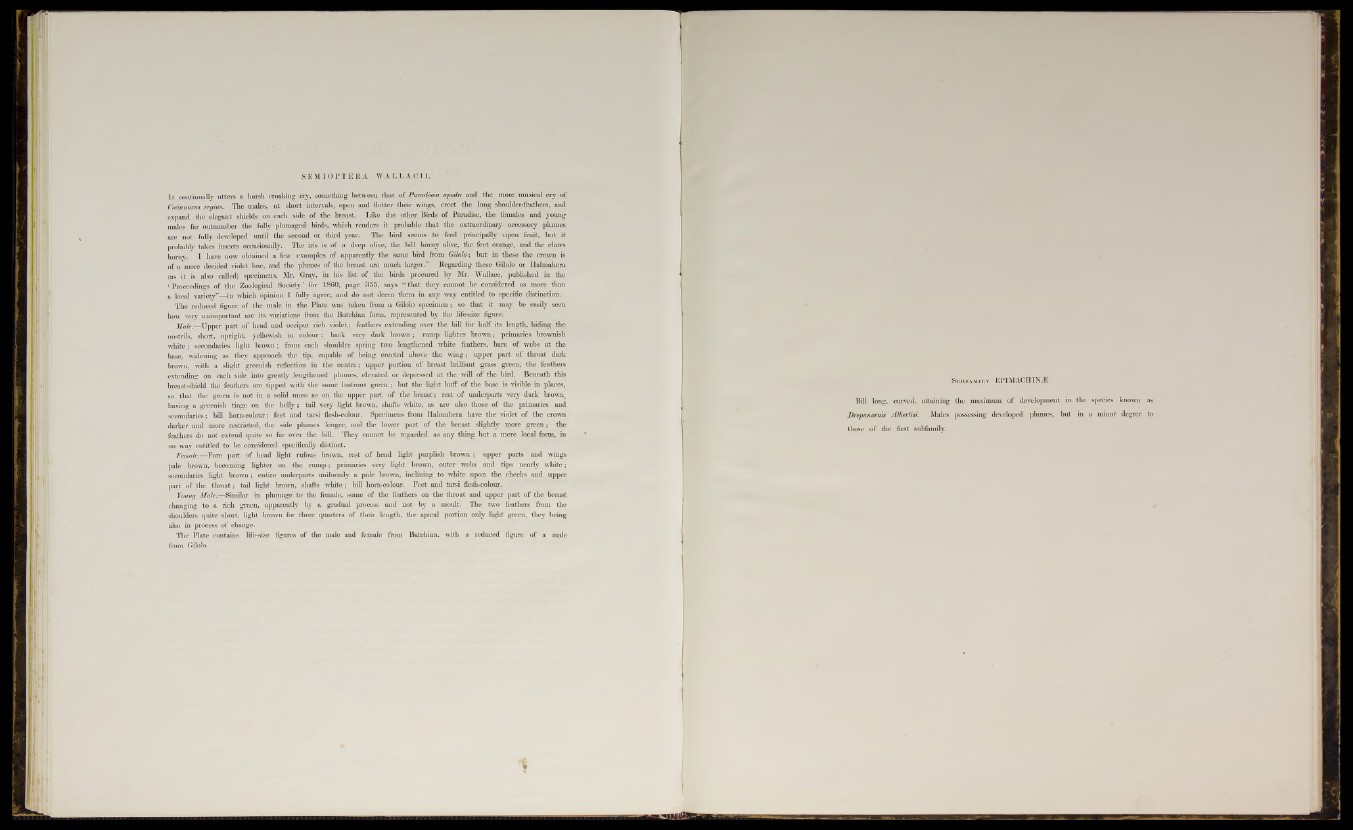
S EM I O P T E R A W A L L A C H .
It continually utters a harsh croaking cry, something between that of Paradisea apoda and the more musical cry of
Cicinnurus rcgim. The males, at short intervals, open and flutter their wings, erect the long shoulder-feathers, and
expand the elegant on each side of the breast. Like the other Birds of Paradise, the females and young
males far outnumber the fully plumaged birds, which renders it probable that the extraordinary accessory plumes
are not fully developed until the second or third year. The bird seems to feed principally upon , fruit, hut it
probably takes insects occasionally. The iris is of a deep olive, the bill homy olive, the feet orange, and the claws
homy. I have now obtained a few examples of apparently the same bird from Gilolo; but in these the crown is
of a more decided violet hue, and the plumes of the breast are much larger.” Regarding these Gilolo or Haimahera
(as it is also called) specimens, Mr. Gray, in his list of the birds procured by Mr. Wallace, published in the
i Proceedings of the Zoological Society ’ for 1860, page 355, says “ that they cannot be considered as more than
a local variety”^—in which opinion I fully agree, and do not deem them in any way entitled to specific distinction.
The reduced figure of the male in the Plate was taken from a Gilolo • specimen; so that it may be easily seen
how very unimportant are its variations from the Batchian form, represented by the life-size figure.
Male. Upper part of head and occiput rich, violet; feathers extending over the bill for half its length, hiding the
nostrils, short, upright, yellowish in colour; back very dark brown; rump lighter brown; primaries brownish
white ; secondaries light brown; from each shoulder spring two lengthened white feathers, bare of webs at the
base, widening as they approach the tip, capable of being erected above the wing; upper part o f throat dark
brown, with a slight greenish reflection in the centre ; upper portion o f breast brilliant grass green, the feathers
extending on each side into greatly lengthened plumes, elevated or depressed at the will o f the bird. Beneath this
breast-shield the feathers are tipped with the same lustrous green; hut the light buff of the base is visible in places,
so that the green is not in a solid mass as on the upper part of the breast; rest of underparts very dark brown(
having a greenish tinge on the belly; tail very light brown, shafts white, as are also those of the primaries and
secondaries; bill horn-colour; feet and tarsi flesh-colour. Specimens from Haimahera have the violet o f the crown
darker and more restricted,, the side plumes longer, and the lower part o f the breast slightly more green; the
feathers do not extend quite so far over the bill. They cannot be regarded as any thing but a mere local form, in
no way entitled to be considered specifically distinct.
Female.—Fore part of head light rufous brown, rest o f head light purplish brown ; upper parts and wings
pale brown, becoming lighter on the rump; primaries very light brown, outer webs and tips nearly white;
secondaries light brown; entire underparts uniformly a pale brown, inclining to white upon the cheeks and upper,
part of the throat; tail light brown, shafts white; bill horn-colour. Feet and tarsi flesh-colour.
Young Male.—Similar in plumage to the female, some o f the feathers on the throat and upper part of the breast
nlmnging to a rich green, apparently by a gradual process and not by a moult. The two feathers from the
shoulders quite short, light brown for three quarters of their length, the apical portion only light green, they being
also in process of change.
The Plate contains life-size figures of the male and female from Batchian, with a reduced figure o f a male
from Gilolo.
S u b f a m i l y EPIMACHIN2E.
• Bill long, curved, attaining the maximum of development in the species
Drepanomis Albertm. Males possessing developed plumes, but in a minor
those of the first subfamily.
known as
degree to